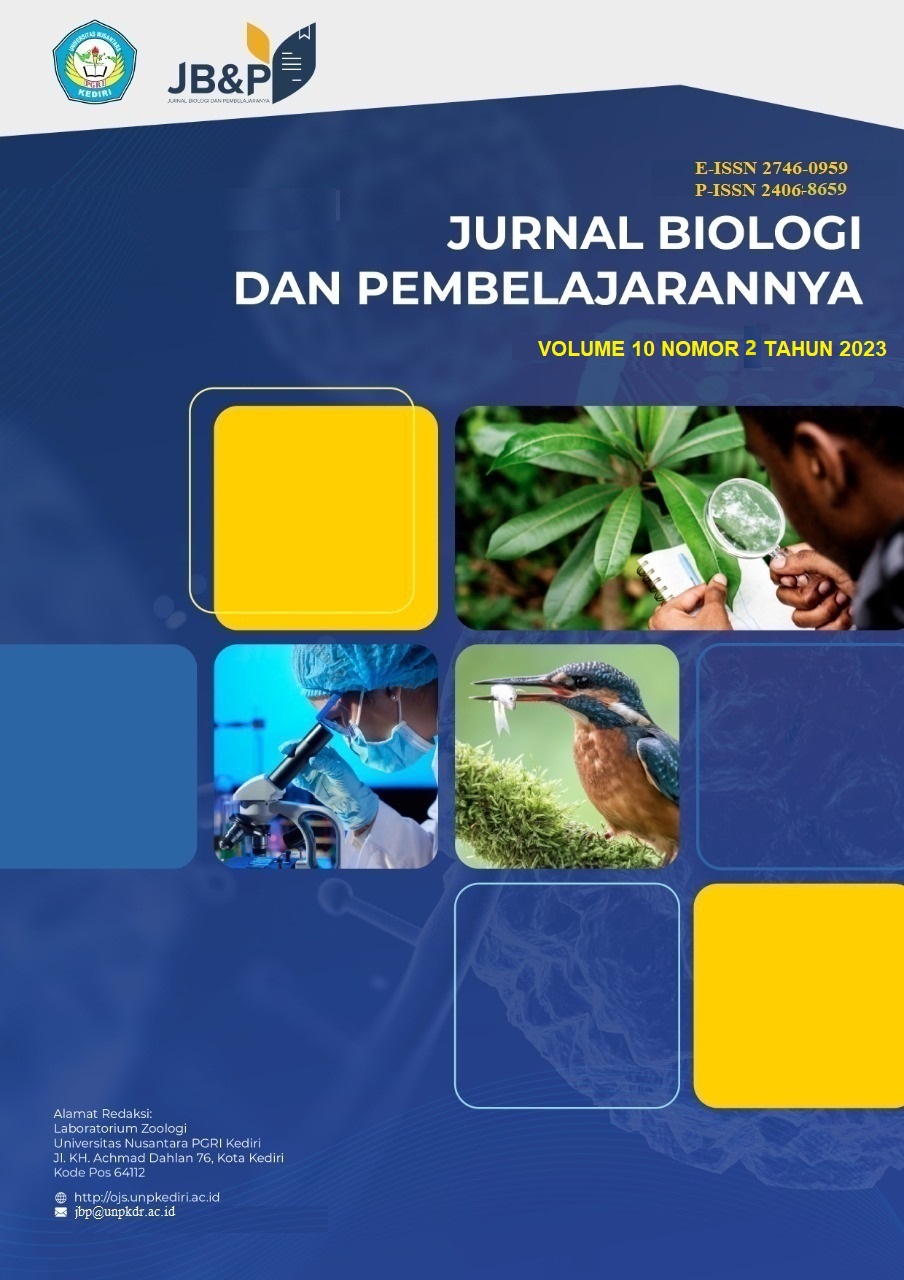Keanekaragaman Serangga Nokturnal Di Komplek Pertamina Bagus Kuning Palembang
DOI:
https://doi.org/10.29407/jbp.v10i2.20239Keywords:
Insect Nocturnal, Light Trap, ComplexAbstract
Studies on the diversity of nocturnal insects in the city of Palembang, especially in the Pertamina Bagus Kuning Complex, Palembang, are still limited, so it is necessary to carry out research on the diversity of nocturnal insects in the area. This study aims to determine the level of diversity of nocturnal insects active in the Pertamina Bagus Kuning Complex. This research was conducted in December 2022. This research was conducted using light traps as a place to catch nocturnal insects. The method used is a descriptive survey by direct observation of insects in the Pertamina Bagus Kuning Complex. The number of light traps used was 2 traps placed at 2 different stations, the light traps were placed at 18.00 WIB and collected the next day at 05.30 WIB. The results showed that nocturnal insects caught by light traps were 35 individuals from 8 species and 5 orders. The diversity of nocturnal insect species in the Pertamina Bagus Kuning Complex area based on Shannon-Weiner (H') of 1.74753679 is classified as moderate.
References
Aditama, R. C., & Kurniawan, N. (2013). Struktur Komunitas Serangga Nokturnal Areal Pertanian Padi Organik pada Musim. Jurnal Biotropika |, 1(4), 186.
Alfira, Siti, & Hanim, N. (2022). Pengaruh Warna Lampu Terhadap Kehadiran Serangga Nocturnal Di Kawasan Kampus Uin Ar- Raniry Banda Aceh. Prosiding Seminar Nasional Biotik, 9(1), 12–15.
Andrianni, D. M., Setyaningsih, M., & Susilo, S. (2017). Keanekaragaman dan Pola Penyebaran Insekta Permukaan Tanah di Resort Cisarua Taman Nasional Gunung Gede Pangrango Jawa Barat. Bioeduscience, 1(1), 24. https://doi.org/10.29405/bioeduscience/24-30111179
Barroso, A., Haifig, I., Janei, V., Da Silva, I., Dietrich, C., & Costa-Leonardo, A. M. (2017). Effects of flickering light on the attraction of nocturnal insects. Lighting Research and Technology, 49(1), 100–110. https://doi.org/10.1177/1477153515602143
Bolliger, J., Hennet, T., Wermelinger, B., Blum, S., Haller, J., & Obrist, M. K. (2020). Low impact of two LED colors on nocturnal insect abundance and bat activity in a peri-urban environment. Journal of Insect Conservation, 24(4), 625–635. https://doi.org/10.1007/s10841-020-00235-1
Debora, E., & Satria, R. (2019). Diversity Of Nocturnal Insects (Insecta) In Bukik Kasang, Padang Pariaman, West Sumatra. Bioscience, 3(2), 127. https://doi.org/10.24036/0201932104575-0-00
Faradila, A., Nukmal, N., & Dania Pratami dan Tugiyono. (2020). Keberadaan Serangga Malam Berdasarkan Efek Warna Lampu Di Kebun Raya Liwa. Bioma: Berkala Ilmiah Biologi, 22(2), 130–135.
Gaston, K. J., & Sánchez De Miguel, A. (2022). Environmental Impacts of Artificial Light at Night. Annual Review of Environment and Resources, 47(2), 373–398. https://doi.org/10.1146/annurev-environ-112420-014438
Hadi, M., Martitik, D. A., & Tarwotjo, U. (2019). Ecological characteristics of nocturnal pest insects and their natural enemies in green bean fields. Journal of Physics: Conference Series, 1217(1). https://doi.org/10.1088/1742-6596/1217/1/012176
Hakami, A. R., Khan, K. A., Ghramh, H. A., Ahmad, Z., & AL-Zayd, A. A. A. (2020). Impact of artificial light intensity on nocturnal insect diversity in urban and rural areas of the Asir province, Saudi Arabia. PLoS ONE, 15(12 December), 1–10. https://doi.org/10.1371/journal.pone.0242315
Lehtonen, T. K., & Kaitala, A. (2020). Leave me alone: Solitary females attract more mates in a nocturnal insect. Behavioral Ecology, 31(4), 1040–1045. https://doi.org/10.1093/BEHECO/ARAA049
Musnoi, A., Hutapea, S., & Aziz, R. (2017). Pengaruh Pemberian Biochar Dan Pupuk Bregadium Terhadap Pertumbuhan Dan Produksi Tanaman Sawi Hijau (Brassica rapa var. parachinensis L). Agrotekma: Jurnal Agroteknologi Dan Ilmu Pertanian, 1(2), 160. https://doi.org/10.31289/agr.v1i2.1132
Nurahmadhani, A., Zahabyyah, H., & Kamal, S. (2015). Komposisi dan Keanekaragaman Serangga Nocturnal di Kawasan Kampus UIN Ar-Raniry Banda Aceh. 9(2), 39–42.
Owens, A. C. S., Cochard, P., Durrant, J., Farnworth, B., Perkin, E. K., & Seymoure, B. (2020). Light pollution is a driver of insect declines. Biological Conservation, 241(September 2019), 108259. https://doi.org/10.1016/j.biocon.2019.108259
Owens, A. C. S., & Lewis, S. M. (2018). The impact of artificial light at night on nocturnal insects: A review and synthesis. Ecology and Evolution, 8(22), 11337–11358. https://doi.org/10.1002/ece3.4557
Pulungan, Y. A., & Afrianti, S. (2021). Keanekaragaman Serangga Malam (Nokturnal) Di Kebun Kelapa Sawit Pt. Victorindo Alam Lestari. Jurnal Pertanian Berkelanjutan, 9(2), 76–87.
Ramadhan, R. A. M., Mirantika, D., & Septria, D. (2020). Keragaman Serangga Nokturnal dan Peranannya Terhadap Agroekosistem. Agroscript, 2(2), 114–125.
Ramadhanita, E., Fitria, N., & Harpida, R. (2018). Jenis-Jenis Serangga Nokturnal Di Kawasan Desa Deudap (Pulo Nasi), Kecamatan Pulo Aceh, Kabupaten Aceh Besar, Provinsi Aceh. Prosiding Seminar Nasional Biotik, 86–89.
Ting, J. S., Atiqah, A. R. N., Ng, Y. F., Yaakop, S., & Zubaid, A. (2016). Insect Diversity and Abundance During The Crepuscular and Nocturnal Temporal Periods In The Kota Gelanggi Limestone Complex, Pahang, Malaysia. Centre for Insects Systematic, 15(1), 165–175. https://core.ac.uk/download/pdf/196255896.pdf
Treitler, J. T., Heim, O., Tschapka, M., & Jung, K. (2016). The effect of local land use and loss of forests on bats and nocturnal insects. Ecology and Evolution, 6(13), 4289–4297. https://doi.org/10.1002/ece3.2160
Urach Ferreira, P. H., & Ferreira, M. da C. (2023). Sphenophorus levis Behavior Studies: Evaluating Insect Attractiveness or Repellency to One Insecticide Treatment and Assessing Nocturnal Insect Activity and Location Pattern. Insects, 14(2). https://doi.org/10.3390/insects14020205
Villarroya-Villalba, L., Casanelles-Abella, J., Moretti, M., Pinho, P., Samson, R., Van Mensel, A., Chiron, F., Zellweger, F., & Obrist, M. K. (2021). Response of bats and nocturnal insects to urban green areas in Europe. Basic and Applied Ecology, 51, 59–70. https://doi.org/10.1016/j.baae.2021.01.006
Wahyuni, S., Rendo, D., & Sarah, M. (2022). Penerapan Teknologi Light Trap Pada Pertanaman Padi di Desa Detusoko Barat Nusa Tenggara Timur. 6(1), 217–226.
Downloads
Published
Issue
Section
License
Authors who publish with this journal agree to the following terms:
- Copyright on any article is retained by the author(s).
- The author grants the journal, right of first publication with the work simultaneously licensed under a Creative Commons Attribution License that allows others to share the work with an acknowledgment of the work’s authorship and initial publication in this journal.
- Authors are able to enter into separate, additional contractual arrangements for the non-exclusive distribution of the journal’s published version of the work (e.g., post it to an institutional repository or publish it in a book), with an acknowledgment of its initial publication in this journal.
- Authors are permitted and encouraged to post their work online (e.g., in institutional repositories or on their website) prior to and during the submission process, as it can lead to productive exchanges, as well as earlier and greater citation of published work.
- The article and any associated published material is distributed under the Creative Commons Attribution-ShareAlike 4.0 International License













